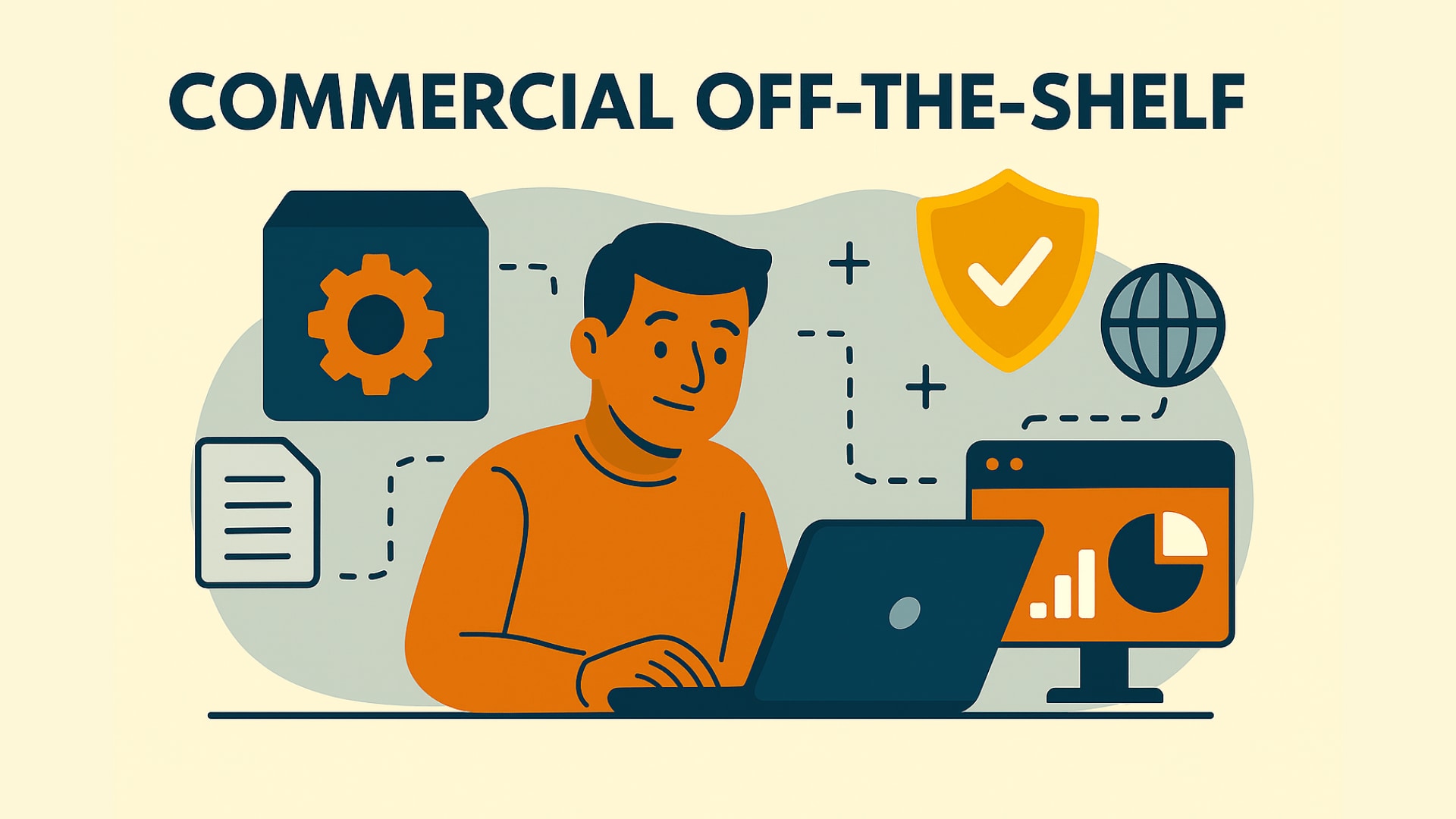
Companies are constantly looking for ways to improve their operations without incurring significant costs. One popular solution is Commercial Off-the-Shelf (COTS) software. This term refers to pre-packaged software and hardware products that are ready to use right out of the box. While COTS products are not custom-built for a specific organization, they offer a practical and cost-effective solution for businesses in need of robust, proven tools. However, like any software solution, they come with both advantages and challenges. This guide will take a closer look at what COTS software is, its role in cybersecurity, and how businesses can make the most of it.
Table of contents
Understanding Commercial Off-the-Shelf Software
COTS stands for Commercial Off-the-Shelf products. These are widely available software and hardware solutions developed to meet common business needs. Unlike custom software, which is built for specific business requirements, COTS solutions are pre-developed and sold to a broad market. They are intended to be easily implemented and are typically much quicker and less expensive to deploy compared to custom-built alternatives. Whether it’s accounting software, customer relationship management (CRM) systems, or cybersecurity tools, COTS products provide standardized functionalities that can be used across industries.
What makes COTS so attractive to businesses is its ease of access and quick implementation. These solutions are already developed, tested, and ready to use, meaning companies can avoid the time and expense of building their own software from scratch. However, COTS software is not without its trade-offs, especially when it comes to customization, integration, and cybersecurity.
Role of COTS in Cybersecurity
As cybersecurity threats become more sophisticated, businesses are looking for cost-effective ways to bolster their defenses. This is where COTS software plays a crucial role. Many Commercial Off-the-Shelf solutions are specifically designed to address security needs, offering businesses access to high-quality tools that can help protect their networks and sensitive data.
Cybersecurity-focused COTS products provide a range of features to defend against cyber threats, including intrusion detection systems, firewalls, and data encryption tools. These tools are built to handle a wide range of security challenges, from preventing unauthorized access to safeguarding against malware attacks. However, while these products can offer strong security measures, businesses must be aware of potential vulnerabilities inherent in widely-used solutions.
Benefits of COTS Software in Cybersecurity
One of the key advantages of COTS software, particularly in cybersecurity, is its affordability. Developing a custom-built security solution is expensive, often requiring significant time and resources. COTS software, on the other hand, provides businesses with access to cutting-edge security tools at a much lower price point. Vendors benefit from producing products in bulk, which helps lower the cost for individual customers.
Moreover, Commercial Off-the-shelf software comes with the advantage of quick deployment. Since these tools are already developed, businesses can implement them quickly to address urgent security needs. For organizations looking to stay ahead of cyber threats, this fast deployment is critical.
COTS products also often come with regular updates from vendors. These updates are essential for maintaining strong security, as they address newly discovered vulnerabilities and patch weaknesses. With cybersecurity threats evolving at a rapid pace, having access to regular updates ensures that businesses can stay protected against the latest risks.
Risks and Challenges of COTS in Cybersecurity
Despite their many advantages, COTS products are not without their risks, especially in the context of cybersecurity. One of the primary concerns is the exposure to security vulnerabilities. Since these products are mass-produced and used by a wide range of businesses, they are frequent targets for cybercriminals. A vulnerability discovered in a popular COTS product can be exploited by hackers, putting all users of that product at risk.
Another challenge with COTS software is compatibility. While many COTS products are designed to integrate easily with other systems, there can still be issues when trying to combine them with existing infrastructure, especially in organizations with complex or legacy systems. Businesses may face integration difficulties that can complicate the deployment and effectiveness of the software.
Additionally, businesses using COTS software have limited customization options. These products are not tailored to the specific needs of any single business, which means that organizations may need to adapt their processes to fit the software rather than the other way around. This lack of flexibility can be a significant drawback for companies with unique or highly specialized requirements.
Best Practices for Using COTS in Cybersecurity
Given the risks and challenges associated with COTS software, businesses must follow best practices to ensure they can fully leverage its benefits while mitigating the associated risks. These practices include:
Regularly Updating and Patching Software
To keep your COTS software secure, it’s important to stay on top of updates and patches. Vendors regularly release updates to fix security vulnerabilities and enhance software functionality. By applying patches promptly, businesses can ensure they are protected from emerging threats. A proper patch management strategy will allow your organization to apply these updates as soon as they are available, reducing the risk of cybercriminals exploiting known vulnerabilities. Businesses should set up a process for monitoring updates and ensure they are tested for compatibility before being deployed.
Conducting Vendor Assessments
Before purchasing COTS software, businesses should assess the vendor’s reputation and security practices. A strong vendor will have a proven track record and be transparent about their approach to security. It’s crucial to evaluate their support services, including how they handle updates, patches, and potential security issues. Understanding how often the vendor releases updates and their responsiveness to vulnerabilities will help businesses ensure they are making a secure, long-term investment in COTS products.
Implementing Robust Security Controls
While COTS software comes with built-in security features, it’s important to supplement them with additional security measures. Businesses should enforce access control policies and implement encryption to protect sensitive data. A layered security approach can enhance your defenses, ensuring that if one security measure fails, others remain in place. Adding intrusion detection systems (IDS) and other protective layers can further reduce the risk of cyberattacks, helping businesses protect their data and systems from potential breaches.
CAPTCHA Solution for Enhanced Security
In addition to regular updates and security controls, businesses should implement CAPTCHA technology to protect web interactions from bots. Solutions like captcha.eu offer a secure, privacy-compliant way to distinguish between human users and automated bots. Bots can be used to conduct a wide range of malicious activities, such as scraping sensitive data or attempting unauthorized logins. By incorporating CAPTCHA into web forms, login pages, and account registrations, businesses can safeguard against these threats and enhance their overall security strategy.
Layered Security Approach
A multi-layered approach that uses different COTS security products in tandem can help provide comprehensive protection. For example, businesses might use one COTS product for encryption, another for firewall protection, and yet another for intrusion detection. Combining these tools can help ensure that the organization has robust defenses against a wide range of cyber threats.
Conclusion
Commercial Off-the-Shelf (COTS) software offers a cost-effective and efficient solution for businesses seeking to address common operational needs, including cybersecurity. With quick deployment, lower costs, and access to advanced security features, COTS products are an attractive option for many organizations. However, businesses must be aware of the potential risks, including security vulnerabilities, integration challenges, and limited customization options.
To ensure that COTS products serve their purpose effectively, businesses must implement strong cybersecurity practices. This includes regular updates, vendor assessments, multi-layered security strategies, and using tools like CAPTCHA to protect against automated threats. By managing COTS software carefully and integrating it with other security measures, businesses can leverage the benefits of mass-market solutions while mitigating the risks associated with their use.
As cybersecurity threats continue to evolve, businesses must stay proactive in securing their operations. With the right tools and strategies in place, COTS software can be an invaluable asset in protecting digital assets and maintaining a secure online presence. By integrating solutions, like captcha.eu, organizations can ensure that their COTS-based systems are fully protected against cyber threats, making them a safe and reliable choice in today’s business environment.
FAQ – Frequently Asked Questions
What is Commercial Off-the-Shelf software?
COTS (Commercial Off-the-Shelf) software refers to pre-packaged software solutions that are mass-produced and available for purchase to the general public. These solutions are designed to address common business needs, such as customer relationship management, office productivity, and cybersecurity, without requiring customization.
What are the advantages of using COTS software?
The primary advantages of COTS software include cost-effectiveness, quick deployment, and reliability. Since COTS products are mass-produced, they tend to be more affordable than custom-built solutions. Additionally, they are ready to use immediately, which means businesses can implement them quickly. Regular updates and a large customer base also contribute to their reliability.
What are the challenges associated with COTS software?
While COTS products offer many benefits, they also present challenges such as limited customization, compatibility issues, and vendor dependency. These solutions are designed for a broad audience and may not meet the specific needs of your business. Additionally, integrating COTS software with existing systems can sometimes be complex, and reliance on the vendor for updates and support can pose risks.
How does COTS software impact cybersecurity?
COTS software plays a significant role in cybersecurity by providing businesses with advanced security features, such as firewalls, encryption, and intrusion detection systems. However, because COTS products are widely used, they can also be targeted by cybercriminals. It’s essential for businesses to ensure that their COTS software is regularly updated and patched to protect against known vulnerabilities.
What security risks come with using COTS software?
The main security risk with COTS software is the potential for exploitable vulnerabilities. Since COTS products are used by many businesses, they can become a target for cyberattacks. If vulnerabilities in these products are not addressed through timely updates, they could be exploited by hackers to gain unauthorized access to sensitive data or disrupt operations.
How can businesses secure their COTS software?
Businesses can enhance the security of their COTS software by adopting a multi-layered security approach. This includes using robust security measures like encryption, access controls, and intrusion detection systems. Additionally, integrating CAPTCHA solutions, such as captcha.eu, can help protect websites and applications from malicious bot activity, preventing automated threats from exploiting vulnerabilities in COTS products.
100 free requests
You have the opportunity to test and try our product with 100 free requests.
If you have any questions
Contact us
Our support team is available to assist you.




